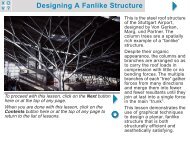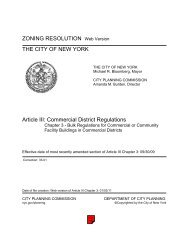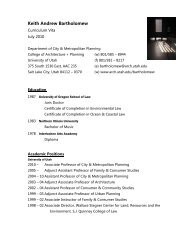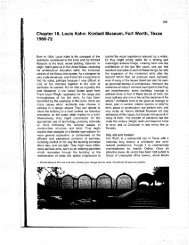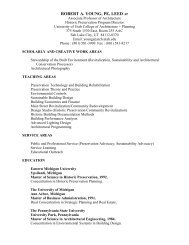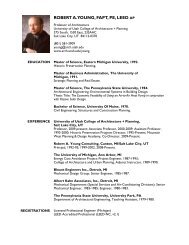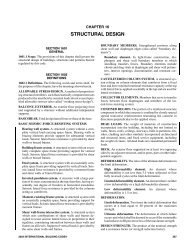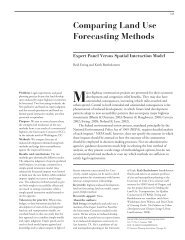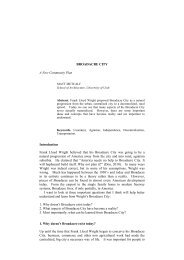The Josephine Baker House: For Loos's Pleasure Farčs el-Dahdah ...
The Josephine Baker House: For Loos's Pleasure Farčs el-Dahdah ...
The Josephine Baker House: For Loos's Pleasure Farčs el-Dahdah ...
Create successful ePaper yourself
Turn your PDF publications into a flip-book with our unique Google optimized e-Paper software.
<strong>The</strong> <strong>Josephine</strong> <strong>Baker</strong> <strong>House</strong>: <strong>For</strong> <strong>Loos's</strong> <strong>Pleasure</strong><br />
Farès <strong>el</strong>-<strong>Dahdah</strong>; Stephen Atkinson<br />
Assemblage, No. 26. (Apr., 1995), pp. 72-87.<br />
Stable URL:<br />
http://links.jstor.org/sici?sici=0889-3012%28199504%290%3A26%3C72%3ATJBHFL%3E2.0.CO%3B2-V<br />
Assemblage is currently published by <strong>The</strong> MIT Press.<br />
Your use of the JSTOR archive indicates your acceptance of JSTOR's Terms and Conditions of Use, available at<br />
http://www.jstor.org/about/terms.html. JSTOR's Terms and Conditions of Use provides, in part, that unless you have obtained<br />
prior permission, you may not download an entire issue of a journal or multiple copies of articles, and you may use content in<br />
the JSTOR archive only for your personal, non-commercial use.<br />
Please contact the publisher regarding any further use of this work. Publisher contact information may be obtained at<br />
http://www.jstor.org/journals/mitpress.html.<br />
Each copy of any part of a JSTOR transmission must contain the same copyright notice that appears on the screen or printed<br />
page of such transmission.<br />
JSTOR is an independent not-for-profit organization dedicated to and preserving a digital archive of scholarly journals. <strong>For</strong><br />
more information regarding JSTOR, please contact support@jstor.org.<br />
http://www.jstor.org<br />
Wed Apr 4 03:51:28 2007
1. Le Corbusier, Standing Woman<br />
(<strong>Josephine</strong> <strong>Baker</strong>), 1929<br />
Far& <strong>el</strong>-<strong>Dahdah</strong> teaches in the School<br />
of Architecture, Rice University.<br />
<strong>The</strong> wire-frame mod<strong>el</strong> for the <strong>Josephine</strong><br />
<strong>Baker</strong> <strong>House</strong> was created by Stephen<br />
Atkinson in Computer Vision on a Sun<br />
Workstation. <strong>The</strong> computer image were<br />
rendered using a Silicon Graphics<br />
Workstation.<br />
Atkinson teaches at the Boston<br />
Architectural Center and is a designer<br />
with Machado & Silvetti Associates.<br />
Assemblage 26 72-87 0 1995 by the<br />
Massachusetts Institute of Technolog).<br />
Fares <strong>el</strong>-<strong>Dahdah</strong><br />
<strong>The</strong> <strong>Josephine</strong> <strong>Baker</strong><br />
<strong>House</strong>: <strong>For</strong> <strong>Loos's</strong><br />
<strong>Pleasure</strong><br />
<strong>The</strong> narrative history of an architecture complicit with a<br />
subject's affects has yet to be written. Examples are rare<br />
when, in an architectural treatise, love is a semantic notion<br />
and not its function, as in Claude-Nicolas Ledoux's Projet<br />
d'une maison de plaisirs. An amorous architecture may, in<br />
fact, find a theoretical point of departure somewhere in the<br />
fifteenth century when love becomes an obsessive feature<br />
for Alberti - an obsession, we are told, later realized in<br />
Francesco Colonna's Hypnerotomachia Poliphili.' Colonna's<br />
treatise takes the form of a love story in which buildings be-<br />
come metaphors for the protagonist's lover. It is an originary<br />
moment, perhaps, when a building is described as both an<br />
object of desire and as a quasi-subject who might actually<br />
enjoy being loved.] In the Age of Enlightenment, one also<br />
finds instances when love meets architecture, when laws of<br />
seduction are ratified in architectural theory - in fictions on<br />
buildings and in built form. Planimetric distribution, for<br />
example, becomes with Nicolas le Camus de Mkzikres a<br />
distribution of pleasures when a particular building type,<br />
such as an hbt<strong>el</strong> particulier, is organized r<strong>el</strong>ative to a series of<br />
tableaux, each meant to provoke a particular sensation in the<br />
room's occupant. Indeed, de Mkzi6res writes on what until<br />
then had been given little attention: "affections of the soul."3<br />
Irr<strong>el</strong>evant of origins, examples can certainly be collected for a<br />
history of an architectural patronage in which sentiment and<br />
affects are part of the program. It is a history that might begin<br />
with a seventeenth-century folie and consist of a long list of<br />
architectural commissions for the Duc de Rich<strong>el</strong>ieu, Ma-<br />
dame de Pompadour, La Guimard, William Beckford,
Ludwig I1 of Bavaria, Gabri<strong>el</strong>e D'Annunzio, Carlos<br />
Beistegui, among many others - or, as this essay will later<br />
describe, for <strong>Josephine</strong> <strong>Baker</strong>.<br />
<strong>The</strong> phrase "bach<strong>el</strong>or machine" has often been attributed to<br />
such an architecture of pleasure, which is appropriate inso-<br />
far as it connotes a kind of trap that works both ways (trap-<br />
ping the trapper just as it might the prey) and inasmuch as<br />
we understand a machine to be neither a tool nor a weapon.<br />
A bach<strong>el</strong>or machine is an apparatus that, once set in mo-<br />
tion, orchestrates reversible roles akin to those played in<br />
seduction, wherein while the seducer seduces, the seduced<br />
may manipulate the seducer's advances. Seduction is thus<br />
what makes a machine wait for any action to make it work,<br />
be it that of the seducer or the seduced. <strong>For</strong> just as the cogs<br />
of a machine reverse r<strong>el</strong>ations of power, so plots of seduc-<br />
tion confuse r<strong>el</strong>ationships in the name of desire. <strong>The</strong> bach-<br />
<strong>el</strong>or machine is, in fact, a hypnotic mechanism provoked by<br />
the seducer yet dependent on the suggestionability of the<br />
hypnotizedlseduced. <strong>The</strong> phrase "bach<strong>el</strong>or machine" be-<br />
comes inappropriate, however, once its gender reference is<br />
fixed and once it connotes a space of violation; in this case,<br />
it should be called a "bach<strong>el</strong>or's weapon," ammunition for<br />
which is found in the domain of virility. <strong>The</strong> distinction<br />
resides in directional, rifl<strong>el</strong>ike, nature of rape and the revers-<br />
ible, machin<strong>el</strong>ike, nature of seduction. By name, this ma-<br />
chine for seduction b<strong>el</strong>ongs to the space of bach<strong>el</strong>ordom<br />
and serves both a Don Giovanni and a Madame de Pompa-<br />
dour just as it might serve the pleasures of their often ig-<br />
nored lovers. It has been suggested that the blame for having<br />
ignored seduction as desire falls on the experts of gallant<br />
literature who "study it in terms of performance," whereby<br />
seducers are catalogued, classified, and "immobilized de-<br />
pending on their successes or failures," while the manipu-<br />
lative abilities of the seduced are perpetually ign~red.~<br />
Whether called vigne, folie, petite maison, gar~onnidre, or<br />
bach<strong>el</strong>or pad, this machine ought perhaps to be thought of<br />
as that which serves those who, for one reason or another,<br />
"bach it": that is, as the literal mechanism for amorous con-<br />
quests that corroborates, outside matrimony, the affective<br />
scenarios between the machinist and the machine's in-<br />
truder. In literature, at least, it is an apparatus that has<br />
served men, women, and cross-dressers, be they a Marquis<br />
de Trkmicour, a Marquise de Palmarsze, or a Julie who,<br />
assemblage 26<br />
dressed as a man, seduces her lover's mistress in a petite<br />
maison.'<br />
<strong>The</strong> existence of such amorous machines in built form<br />
undoubtedly dates as far back as their own archetype: the<br />
box of Pandora. In the eighteenth century, however, this<br />
"surprise box" became literalized in plays and nov<strong>el</strong>las as<br />
w<strong>el</strong>l as in police reports. As early as 1740, Charles-Jean-<br />
Fran~oisHCnault defined the petite maison as a space of<br />
alterity expressly designed for amorous escapades: "they<br />
were invented only to be entered stealthily in order to wait<br />
for someone who could not be otherwise seen without con-<br />
~equence."~ Police scrutiny also produced a master "voyeur,"<br />
M. Berryer, who "every morning . . . d<strong>el</strong>ighted in the<br />
reports his sleuths had given him on the debaucheries of<br />
those he ~urveyed."~ Indeed, by 1752 M. Berryer had made<br />
a census of all Parisian bach<strong>el</strong>or machines.<br />
When occupied, or set in motion, a petite maison literally<br />
moves, with its "flying-tables" that sink to kitchens b<strong>el</strong>ow<br />
and its "sliding mirrors" that transform rooms into jew<strong>el</strong>ry<br />
boxes. Mechanical dining tables, for instance, not only<br />
heightened the displays of gastronomic feasts, but actually<br />
kept the identity of guests a secret from the gossip of ser-<br />
vants. Madame de Pompadour had such a table built for<br />
her Petit Chlteau de Choisy as one of the architectonic<br />
contrivances she invented to alleviate the king's boredom<br />
and thereby remain his favorite. Jules and Edmond de<br />
Goncourt describe the Petit Chlteau as a space appropri-<br />
ated by the royal mistress to "lure" her king:<br />
Choisy owned by the king, seemed to become his mistress' prop-<br />
erty, given all the efforts she put into its emb<strong>el</strong>lishments and all<br />
the expenditures she ordered for it. . . . <strong>The</strong> finest of details<br />
demonstrated the d<strong>el</strong>icacy of her inventions. Was it not she who<br />
orchestrated [in] this enchanted castle . . . the flying table she<br />
had invented in collaboration with an engineer? . . . It was Ma-<br />
dame de Pompadour's effort and victory to instill all of these<br />
rooms with variety and contrast providing the King's ennui with<br />
the distraction of a surprise-box. . . . In splendid architectural<br />
settings . . . the enchantress lured Louis XV.8<br />
Madame de Pompadour invented an architecture that both<br />
promotes its occupant's desires and protects its machinist's<br />
c<strong>el</strong>ibacy, necessary for her condition as mistress. Similarly,<br />
in Jean-Fran~ois de Bastide's nov<strong>el</strong>la, La Petite Maison, the
Marquis de Trtmicour r<strong>el</strong>ies on the machinations of his<br />
house to seduce his guests and, ultimat<strong>el</strong>y, remain a bach<strong>el</strong>~r.~<br />
Bastide's fiction allegorizes a machine that sites as<br />
w<strong>el</strong>l as orchestrates a plot of seduction between the two<br />
protagonists. <strong>The</strong> story is that of a wager between the Marquis<br />
and MClite, in which he dares her to visit his petite<br />
maison and by that alone inevitably be seduced. <strong>The</strong> visit<br />
proceeds as an argument between the Marquis' impatience<br />
to seduce and Mtlite's stalling technique of wanting to see<br />
everything. Her resistance, however, aimed at teasing the<br />
Marquis by inspecting with much curiosity every detail,<br />
triggers the house to reveal its<strong>el</strong>f r<strong>el</strong>ative to a topography of<br />
affects - as a trap meant to capture all her senses. <strong>The</strong><br />
architectural details on which MClite lingers are willingly<br />
displayed and described, for they are precis<strong>el</strong>y the stages a<br />
resistant guest must go through in order for the seductive<br />
machine to work. Mtlite is disconcerted when music is<br />
suddenly heard from behind secret pan<strong>el</strong>s. She is inebriated<br />
by perfumes emanating from the ether of varnishes. She is<br />
blinded by bright spectacles of refracted chand<strong>el</strong>ier's and<br />
shining surfaces covering entire walls. Troubled, she bar<strong>el</strong>y<br />
eats from a dining table that rotates hypnotically and collapses<br />
into the ground. And just as the reader begins to<br />
suspect that the Marquis may be falling in love, Mtlite<br />
succumbs to being touched and looses the wager.<br />
Admitting that architecture will remain amorous as long<br />
as there are lovers, let us now leap across two centuries<br />
to describe Adolf <strong>Loos's</strong> own bach<strong>el</strong>or machine as an<br />
admirateur's letter that was never sent. <strong>For</strong> like Trtmicour<br />
impatient to touch his guest Mtlite, Loos instrumentalizes<br />
a building as a tactile extension of his senses in order to<br />
covet the exoticized body of an absent <strong>Josephine</strong> <strong>Baker</strong>.<br />
Why do I once again turn to writing?<br />
B<strong>el</strong>oved, one mustn't ask such a clear question,<br />
<strong>For</strong> the truth is, I have nothing to t<strong>el</strong>l you,<br />
All the same, your dear hands will touch this note.''<br />
Young Werter's inquiry as to why one writes a love letter<br />
reveals a paradoxical dimension inherent in any amorous<br />
correspondence: a letter is like a signifier that can convey<br />
an amorous message even though it may be empty or say<br />
nothing at all. It is the instrument of a tactile extension just<br />
as it transmits the language of devotion. Roland Barthes<br />
distinguishes, in fact, between two forms of love notes:<br />
there is the amorous correspondence, where one seeks to<br />
"defend positions, insure conquests, [and thereby] articulate<br />
the image of the Other in various points that the letter<br />
will try to touch," and there is the love letter proper, where<br />
one is pur<strong>el</strong>y affectionate, engaging the Other in a "r<strong>el</strong>ationship,<br />
not a corre~pondence."~~ <strong>The</strong> enterprise of writing<br />
amorously can thus be "both empty (encoded) and expressive<br />
(laden with a yearning to express one's desire)."12 A<br />
note sent to the object of one's affections is a d<strong>el</strong>iberate<br />
extension of one's language, an attempt to touch the Other<br />
("as if my words were fingers") despite the message conveyed:<br />
the irreducible "I love In a letter, words need<br />
say nothing at all, "save that it is to you that I t<strong>el</strong>l this nothing"<br />
and, paradoxically, it is via this "nothing" that one<br />
overcomes the Other's absence.14<br />
<strong>The</strong> house that Adolf Loos designed in 1928 at the sup-<br />
posed request of <strong>Josephine</strong> <strong>Baker</strong> is precis<strong>el</strong>y this: a love<br />
note. It is an epistolary attempt to detail her image in "vari-<br />
ous points" through a kind of writing that stretches a third<br />
skin between the body of the architect and that of the<br />
dancer. <strong>The</strong> house is an apparatus (like the note) through<br />
which one can somehow rub against, or trap, a dancer's<br />
exoticized body. It is a building designed as a tactical enter-<br />
prise, as the imaginary "prose" of an amorous conquest in<br />
between whose lines (in between the stripes of its fa~ades<br />
and the distribution of its rooms) one is to decode a longing<br />
to signify desire. In other words, this house corroborates<br />
someone's yearning to touch the absent body of <strong>Josephine</strong>.<br />
And, in the absence of hardly any information regarding<br />
the circumstances of Adolf <strong>Loos's</strong> ever having met<br />
<strong>Josephine</strong> <strong>Baker</strong>, the architect's project (a mod<strong>el</strong> and a few<br />
drawings) is the principal document of this longing, shared<br />
by an entire generation, for the famous American dancer.<br />
An account that does describe Loos meeting <strong>Josephine</strong> and<br />
"verifies" that a house may indeed have been commissioned<br />
appears in Claire <strong>Loos's</strong> biography, Adolf Loos Privat. Mrs.<br />
Loos (nee Beck) cites her husband quoting <strong>Josephine</strong>, as the<br />
dancer complained about another architect's plans for a<br />
house she wished to build. To his surprise, Loos realized<br />
that she was unaware that he, too, was an architect and, in<br />
response, proposed his own services:
It was in Paris. She came up to me and was in a bad mood.<br />
'Imagine Loos!' she said in a sulking tone, 'I want to make a<br />
large, large transformation to my house, and I don't like the<br />
plans of the architects.' I couldn't contain mys<strong>el</strong>f. 'What, you<br />
didn't come to me straight away? Don't you know that I can<br />
design the best plans in the world for you?' Astonished,<br />
JosCphine looked at me with her children's eyes and asked gen-<br />
tly: 'So you are an architect???' - she had no idea who I was -<br />
I designed a plan for JosCphine. . . . I regard it as one of my best.<br />
<strong>The</strong> outer wall is striated with white and black bands of marble<br />
- alternating transvers<strong>el</strong>y."<br />
<strong>Baker</strong> and Loos might have met in Paris, when the architect<br />
was building a house for the dadaist poet Tristan Tzara.<br />
<strong>The</strong>y might even have met in Vienna, when <strong>Baker</strong> was on<br />
tour in 1928. In her many memoirs, however, <strong>Josephine</strong><br />
mentions neither the architect nor a house he had designed<br />
to replace two adjacent houses she owned on Avenue<br />
Bugeaud.16 <strong>The</strong> <strong>Baker</strong> <strong>House</strong> was thus designed for some-<br />
one who, for conjectural reasons, did not speak of it. <strong>Baker</strong><br />
might have never known of <strong>Loos's</strong> design or she might have<br />
d<strong>el</strong>iberat<strong>el</strong>y abstained from acknowledging it; not to men-<br />
tion that the entire event of her t<strong>el</strong>ling Loos about her plans<br />
to build a house might have simply been forgotten by her,<br />
yet strategically remembered by him. In any case, her sup-<br />
posed silence must be noted, for it is that of the fetish who<br />
never replies to the fetishist's advances. <strong>The</strong> <strong>Baker</strong> <strong>House</strong> is<br />
a lover's note that needn't be sent, for it is more significant<br />
to the one who produced it than to the one who, suppos-<br />
edly, asked for it. It is a metonymic object whose sole pur-<br />
pose is to occupy the space where the Other is not and,<br />
paradoxically, to suggest both her absence and presence.<br />
In the <strong>Baker</strong> <strong>House</strong>, one is to linger, waiting to catch a<br />
glimpse of <strong>Josephine</strong> through architectural machinations<br />
meant to exhibit and trap the body of a person whose ab-<br />
sence Loos seems to mind. <strong>Josephine</strong>, in turn, plays a role<br />
of "present absence," which, ironically, can be illustrated in<br />
some of <strong>Loos's</strong> own writing, and in none other than "Orna-<br />
ment and Crime." <strong>For</strong> Loos, ornament's crime is to have<br />
disguised, or dissimulated, the purity of a spatial armature,<br />
which finds its<strong>el</strong>f cluttered with supplements. To accuse<br />
ornament of perjury, however, and to call for its abolish-<br />
ment is, somewhere, an obsession with its absence. <strong>For</strong> it is<br />
through such absence that a seemingly unattainable object<br />
assemblage 26<br />
may, in fact, be acquired: what Loos calls "modern distinction."<br />
In other words, to be situated outside (in the absence<br />
of) fashion is precis<strong>el</strong>y to occupy an alternate space of distinction.<br />
<strong>For</strong> Loos, one is most <strong>el</strong>egant when least noticed,<br />
"when one stands-out as little as possible in the center of<br />
culture."17 Loos insists on the absence of ornament so as to<br />
disguise a certain d<strong>el</strong>ight in the distinction such an absence<br />
procures. Hence Hubert Damisch's claim that "in a<br />
class society the absence of ornament can still be an ornament."18<br />
Absence fulfills what the presence of an ornament<br />
can fulfill no longer since the suggestion of craft comes to<br />
"naturalize" the mass-produced object as distinct from<br />
others.19 Loos precis<strong>el</strong>y minds the notion that fashion<br />
ceases to be truly luxurious when its details are no longer<br />
artfully crafted; and he would, no doubt, disagree with<br />
Barthes's claim that "the detail [the ornament] consecrates<br />
a democracy of budgets while respecting an aristocracy of<br />
tastes."20 To do away with, to sacrifice, ornament is, for<br />
Loos, to evoke nostalgically an unattainable "aristocratic"<br />
object as the essential accessory of "the modern man," who<br />
"is still in our society an isolated man, a forward sentin<strong>el</strong>,<br />
an ari~tocrat."~' Indeed, Loos enjoys paying more for the<br />
absence of what he considers excessive. In a passage from<br />
"Ornament and Crime," the architect disappoints his shoemaker<br />
by requesting a pair of shoes stripped of its signs of<br />
<strong>el</strong>egance, for which lack of production he is ready to pay.<br />
<strong>The</strong> cobbler may have "less work to do, yet" as Loos says, "I<br />
robbed him of all his Ornament, or rather, its<br />
suppression, becomes a source, however sadistic, of d<strong>el</strong>ight.<br />
<strong>Loos's</strong> deploring of excessive notches and holes on his<br />
shoes (while d<strong>el</strong>ighting in their absence) is similar to his<br />
denouncing "the man of our time who daubs the walls<br />
with erotic symbols to satisfy an inner urge."23 It is a sign of<br />
degeneracy of which he may w<strong>el</strong>l be guilty. Loos claims<br />
that degeneracy is determined in "the culture of a country<br />
by the degree to which its lavatory walls are daubed." He<br />
traces this act back to a primitive and savage origin: "the<br />
first work of art, the first action of the first artist daubing on<br />
the wall [is a cross whose horizontal line is] the reclining<br />
woman [and whose vertical line is] the man who penetrates<br />
her." If this indeed implies that culture is measured by the<br />
repression of its "wild" sexual urge, then ornament as w<strong>el</strong>l<br />
as its absence have assumed in <strong>Loos's</strong> discourse the space
2. Adolf Loos, <strong>Josephine</strong> <strong>Baker</strong><br />
<strong>House</strong>, 1928, plans<br />
r Q c. . ,'<br />
2 - .. - -1-<br />
:?:;! '-<br />
b<br />
...* 1 ,..I<br />
-r<br />
+.<br />
of what should ruthlessly be repressed: "the evolution of<br />
culture is synonymous with the removal of ornament from<br />
objects of daily use" <strong>For</strong> Loos, "art is erotic" and a tattoo is<br />
the untamed expression of the "Papuan" he often mentions.<br />
Having thus denounced the degeneracy of "soiled walls" as<br />
the outcome of an inner erotic urge and having gendered<br />
the "trace" as the product of feminine and masculine lines<br />
(borrowed from Mondrian), <strong>Loos's</strong> own "daubing" on the<br />
white faqades of the <strong>Baker</strong> <strong>House</strong> becomes codified as the<br />
marks of a repressed and savage desire: the flagrant script of<br />
<strong>Josephine</strong>'s body, the horizontal trace' as woman. As much<br />
as Loos b<strong>el</strong>ieves that "the modern man who tattoos hims<strong>el</strong>f<br />
is a criminal or a degenerate," he still inscribes the faqade<br />
(of a "Papuan's" house) with the repetitive black horizontal ))I<br />
stripe he had already coded as a reclining woman. By his<br />
own definition, this horizontal tattoo results from an untamed<br />
desire now confronted with a vertical line: the standing<br />
architect who seeks to penetrate, "touch," <strong>Baker</strong>'s body.<br />
*<br />
<strong>Loos's</strong> recurrent mention of a naked Papuan who tattoos<br />
and daubs the marks of his desires is, in the <strong>Baker</strong> <strong>House</strong>,<br />
suddenly materialized (civilized) as a prospective patron<br />
whose nudity the house is to frame. Providing a "Papuan"<br />
with a house, or giving Pandora a box, disguises an anticipation<br />
for her entering it or opening it, so as to fulfill an erotic<br />
fascination with her exoticized body. Just as Loosian house<br />
should be stripped of ornament ("a house is conservati~e"),~~<br />
so should <strong>Josephine</strong> be stripped of hers; after all,<br />
accessories are the only clothes she wears. And although, in<br />
<strong>Loos's</strong> words, "the naked woman . . . may be able to arouse<br />
a man's love, but not to keep it," she becomes, when covered,<br />
when given a house in which to hide, "a riddle to<br />
man, in order to implant in his heart the desire for the<br />
riddle's sol~tion."~~ <strong>Loos's</strong> idea that a fig leaf (that which<br />
covers) is less about a woman's modesty and more about a<br />
game of hide and seek is somehow architecturalized in a<br />
house that covers the naked body of <strong>Josephine</strong>, a house that<br />
she will ultimat<strong>el</strong>y wear. All the accessories her body needs<br />
are in the box that she is given and that, like Pandora, she<br />
will inevitably open. Such mild paranoia can, ironically, be<br />
described in Freudian terms: "the fetish is a substitute for<br />
the woman's (the mother's) penis that the little boy once<br />
b<strong>el</strong>ieved in and does not want to give up." Fetishizing a<br />
garment, for Freud, serves to uphold a disavowal that can<br />
I<br />
I<br />
I<br />
L I..<br />
I
3. <strong>Josephine</strong> <strong>Baker</strong> <strong>House</strong>, mod<strong>el</strong><br />
i<br />
4. <strong>Josephine</strong> <strong>Baker</strong> <strong>House</strong>, <strong>el</strong>evation<br />
-<br />
assemblage 26<br />
"crystallize the moment of undressing, as the last moment<br />
in which the woman could still be regarded as phallic."26<br />
Similarly, <strong>Loos's</strong> insistence on ornament's absent presence,<br />
if not a result of a castration complex, serves at least to<br />
repress an affect of distinction ("no dandy will admit to<br />
being one")27 or, more simply, to disguise an affective penchant,<br />
shared by many, toward <strong>Josephine</strong>'s exotic body.<br />
<strong>The</strong> striated <strong>el</strong>evations are thus the scriptural testament of<br />
<strong>Loos's</strong> phallocratic desire, and the house comes to occupy<br />
the space of what is absent: an impossible r<strong>el</strong>ationship<br />
between the architect and the client. As an object, the<br />
<strong>Baker</strong> <strong>House</strong> is what Barthes might have referred to as an<br />
amorous gift with which one gives one's all, "with this<br />
object I touch you with my phallus."28 <strong>The</strong> black lines<br />
(stripes) on the walls of <strong>Loos's</strong> white architecture constitute<br />
. . .<br />
a kind of writing that "compensates for nothing, sublimates<br />
nothing, . . . it is precis<strong>el</strong>y 'there where you are<br />
This house is a framing apparatus whose function depends<br />
on the absence of whomever is to be seen. It is a machine<br />
idly waiting for some force to make it work. <strong>The</strong> body of<br />
<strong>Josephine</strong> <strong>Baker</strong> is thus strategically framed throughout her<br />
own house precis<strong>el</strong>y because she will not be seen, precis<strong>el</strong>y<br />
because she is the fetish who never responds. In this house,<br />
one can only anticipate the way she might come down the<br />
grand stairs or dive into the swimming pool. Framing her<br />
body corroborates every instance she "might" have been<br />
there dancing, sleeping, or swimming.<br />
In what is, after all, a Parisian hdt<strong>el</strong> particulier, the se-<br />
quence of rooms in the <strong>Baker</strong> <strong>House</strong> abides somewhat<br />
strictly to the rules of eighteenth-century domestic distribu-<br />
tion while simultaneously providing an idiosyncratic topog-<br />
raphy of affects. On entering the house, one is lead up a<br />
grand escalier into a vestibule on the e'tage noble where one<br />
logically finds the salon. Auxiliary to what is usually the<br />
largest room in the house are located a petit salon and a<br />
hidden cafe' (or what would have been called a cabinet,<br />
defined in Augustin-Charles D'Aviler's Coun d'architecture<br />
as "the apartment's most secret room, to write, to st~dy)."~'<br />
In the French hdt<strong>el</strong>, the kitchens are removed as far as<br />
possible from the living or eating quarters, and so in the<br />
<strong>Baker</strong> <strong>House</strong> is the cuisine ("a room that b<strong>el</strong>ongs to the<br />
department of the mouth usually found on the ground-
floor of a building, and sometimes in the ba~ement)."~' Back<br />
in the vestibule, the sequence continues and another escalier<br />
leads to the next floor where one finds the salle a manger<br />
separate from the rest of the apartments.<br />
It may not seem so strange to approximate <strong>Loos's</strong> modernist<br />
house with an eighteenth-century precedent once we realize<br />
that its planimetric distribution not only corresponds to that<br />
of an hbt<strong>el</strong>, but also evokes the "affections of the soul" that<br />
an eighteenth-century architectural theorist would call on<br />
when distributing a plan. This distribution of pleasure is<br />
evident as soon as one walks in the <strong>Baker</strong> <strong>House</strong> and con-<br />
fronts the large, overscaled stairs that could easily b<strong>el</strong>ong to<br />
the Folies Btrgdres. <strong>The</strong> cabaret audience, now reduced to a<br />
single spectator, stands at the entrance looking up. <strong>The</strong><br />
stairs are so long that the anticipated approach of <strong>Josephine</strong><br />
from the vestibule can, at first, only be heard. Her head or<br />
coiffure soon appears and the rest of her body is gradually<br />
revealed, from top to bottom, just as in a striptease, lest we<br />
forget that the American dancer had been imagined stripped<br />
of all her clothes/ornaments. <strong>Josephine</strong> must now "wear"<br />
the stairs, much as she would a dress, in order to play the<br />
stripteaser's subtle game of concealing and revealing. In the<br />
vestibule above and down the stairs, she is imagined danc-<br />
ing forward and backward, teasing and manipulating the<br />
spectator b<strong>el</strong>ow.<br />
<strong>The</strong> framing of motion in the perspectival volume of the<br />
staircase is the architectural equivalent of E. J. Marey's<br />
"chronophotography" as the capturing of a moving object in<br />
a single frame. In a similar way, the stairs become a literal<br />
apparatus that depicts the dancer's nude body in various<br />
points much as in Marc<strong>el</strong> Duchamp's Nude Descending<br />
Staircase. This "demultiplification," to use Duchamp's<br />
term, inspires a kind of reverie that r<strong>el</strong>ativizes time and<br />
space, transforms absence into presence, and becomes a<br />
scenographic mechanism that anticipates capturing the<br />
motion of <strong>Josephine</strong> dancing up and down the stairs.j2 <strong>The</strong><br />
voyeur thus architecturalizes an unconventional mode of<br />
representation in order to transcend <strong>Josephine</strong>'s absence.<br />
<strong>The</strong> house momentarily becomes a photographic apparatus<br />
of "instantaneityn through which "the object is complet<strong>el</strong>y<br />
stretched out as if <strong>el</strong>astic," stretched far enough that it might<br />
be touched.33<br />
Another voyeuristic scenario has already been pointed out<br />
wherein the house's inhabitant "is now the primary object<br />
[of vision], and the visitor, the guest, is the looking subje~t."~~<br />
This occurs in the low passages that provide a place<br />
from which to view into a swimming pool that is dived into<br />
from the bedroom floor above. From these passages one<br />
looks through "transparent windows . . . so that it was possible<br />
to watch swimming and diving in its crystal clear<br />
water, flooded with light from above." This scenario transforms<br />
the window into "a miniature entertainment center,"<br />
borrowed in principle from the maison close (broth<strong>el</strong>) Loos<br />
and his generation, no doubt, freq~ented.~~ <strong>The</strong> origin of<br />
such a voyeuristic practice, we are told, lies the nineteenth<br />
century when the sexual act was abandoned in favor of a<br />
visual orgasm:<br />
Broth<strong>el</strong>s began to provide the tableau vivant; in the grand salon<br />
a kind of erotic machinery is set up by the Madame. On a large<br />
black carpet, naked girls, were seated in suggestive poses, lit by<br />
cand<strong>el</strong>abras; on a rotating floor, women appeared with airs of<br />
wax dolls eternally fixed in voluptuous poses. <strong>The</strong> spectator,<br />
seated in an armchair, could watch and enjoy the scenes in the<br />
room next door.j6<br />
<strong>The</strong> voyeur's window is not unlike <strong>Loos's</strong> clean white wall<br />
that is suddenly daubed with desire. Loos defines the window<br />
as that which serves "to let the light in, not to let the<br />
gaze pass through"; yet here he designs windows that serve<br />
precis<strong>el</strong>y "to let the gaze pass thro~gh."~' If, indeed, "a cultivated<br />
person never looks out of the window," for it is improper<br />
to stare, in <strong>Josephine</strong>'s house the window has been<br />
pushed inward, doubled along the facade, so that <strong>Loos's</strong><br />
modern and distinguished man can do what he is not supposed<br />
to: he can r<strong>el</strong>ease his desire to stare into the exact<br />
space where his gaze is forbidden. <strong>The</strong> act of refraining to<br />
look out occupies the place where the voyeur endlessly<br />
stares through the window on the side of the pool. He looks<br />
while being framed by a window behind him on the house's<br />
facade and from which he is not to look out. <strong>The</strong> window<br />
that does let the gaze pass through opens onto an aquatic<br />
world in which the naked body of <strong>Josephine</strong> might dive at<br />
any moment. So he waits and paints his affects on the tableau<br />
in front of him as a discourse of absence, if not of abstinence.<br />
<strong>The</strong> window thus becomes a tableau of <strong>Loos's</strong> own<br />
desires: "a pure projection, sharp-edged, incorruptible, irre-
versible, which banishes into nothingness everything around<br />
it" but the desire to see <strong>Josephine</strong> dive . . . naked.38<br />
It is clear that the identity of the voyeur is unknown ("the<br />
guest") and understandably so since by definition voyeur-<br />
ism is an anonymous practice. Yet, if in fact, the windows<br />
on the side of the pool confirm other interpretations of this<br />
house, in which openings are made to resemble those of a<br />
peep show, mapping the house's visual dynamics need not<br />
immobilize the players in their respective roles: "where<br />
subjects and objects cannot simply exchange places."39 <strong>The</strong><br />
pleasures of both the observer and the observed are fixed in<br />
their respective positions insofar as one ignores the guest's<br />
thrill in being caught by the host's exhibitionist swim, not<br />
to mention the host's inherent knowledge of the intruder's<br />
position. <strong>The</strong> voyeur's identity might not be known, yet his<br />
eyes are readily borrowed by someone with a perceptual<br />
knowledge of the house's raumplan or by someone who<br />
anticipates how, in such an imagined place, a body might<br />
move, sleep, or swim. <strong>The</strong> house does not b<strong>el</strong>ong to the<br />
person of <strong>Josephine</strong>; it b<strong>el</strong>ongs to that exoticized body she<br />
has constructed and to <strong>Loos's</strong> design pleasure in imagining<br />
it. In fact, there is no guest stricken with scopophilia, there<br />
is, instead, an author writing his desires in a letter - for he<br />
does not see, he imagines vividly.<br />
As the site of high voyeurism, the swimming pool comes to<br />
replace what in an h6t<strong>el</strong> might have been a more conven-<br />
tional boudoir: a special room, indirectly lit ("with fantastic<br />
light-effects"), accessed from the sleeping quarters.40 Having<br />
repeatedly been codified as a woman's territory, the boudoir<br />
is the space in which "a woman withdraws to meditate, or<br />
to read, or to work, in one word, to be alone."41 Modern<br />
dictionaries still define this space as "a woman's dressing<br />
room, bedroom, or private sitting In short, a<br />
boudoir is extraordinary, intimate, and feminine. In the<br />
eighteenth-century nov<strong>el</strong>, it is a place where a woman<br />
withdraws not only to be left alone but to have her intimacy<br />
observed by the reader; as such, <strong>Loos's</strong> pool displays "an<br />
underwater revue" for the spectator who stands hidden<br />
behind a window that acts as a one-way mirr~r.'~<br />
<strong>The</strong> mirror as a boudoir's essential component has been<br />
evident in both the eighteenth-century treatise on architec-<br />
ture as w<strong>el</strong>l as in the libertine nov<strong>el</strong>la describing eigh-<br />
assemblage 26<br />
teenth-century interiors. Le Camus de MCzitres suggests,<br />
for instance, that "openings and repetitions should not be<br />
arranged in this room" and that mirrors should instead<br />
produce perspectival effects.44 In Bastide's La Petite<br />
Maison, a boudoir's alcove is described as being entir<strong>el</strong>y<br />
covered with glass pan<strong>el</strong>s: "all sides and the ceiling of this<br />
niche are covered with mirrors."45 Similarly, the pool in the<br />
<strong>Baker</strong> <strong>House</strong> is made entir<strong>el</strong>y of mirrors, liquid mirrors that<br />
reflect and refract the figure of <strong>Josephine</strong>, whose privacy<br />
becomes spectacle for the spectator in the living room be-<br />
low. What is most private becomes most visible. <strong>The</strong> voyeur<br />
can now "dilute" his gaze in the pool'slmirror's fluid tain<br />
and thus engage, along with his vision, a haptic sense that<br />
makes his eyes, since his hands cannot, caress the absent<br />
body of <strong>Josephine</strong>: "by the gaze I touch, I attain, I seize, I<br />
am seized."46 An aqueouslvisual film thus extends between<br />
the palm of the abstinent voyeur's hand and the figure of<br />
<strong>Josephine</strong>, now paradoxically accessible. <strong>The</strong> boudoir1<br />
swimming pool in the <strong>Baker</strong> <strong>House</strong> is stripped of its many<br />
decorative details and left in a "mercurial" state of pure<br />
pornography. Behind the windowlmirror, Loos stands an-<br />
ticipating the diving body of <strong>Josephine</strong>. Her bathing is re-<br />
turned to that aristocratic era that Loos often recalls, when<br />
the toilette was a public event, or a way to mark one's dis-<br />
tinction, to the time when the toilette became a mecha-<br />
nism for seduction.<br />
Figure Credits Notes<br />
1. Erika Billeter, ed., Le Corbusier 1. See Donald Keith Hedrick, "<strong>The</strong><br />
Secret (Lausanne: Musee Cantonal Ideology of Ornament: Alberti and<br />
des Beaux Arts and <strong>The</strong>odor & Ulla the Erotics of Urban Design," Word<br />
Ahrenberg, 1987). 6Image (1987): 111-37.<br />
2, 3. Ludwig Miinz and Gustav 2. See Liane Lefaivre, "An Erotic<br />
Kiinstler, Adolf Loos: Pioneer of Interference: <strong>The</strong> Unrecognized<br />
Modem Architecture (London: Hypnerotomachia Poliphili,"<br />
Thames and Hudson, 1966). Daidalos (1991): 92-100.<br />
4. P. Groenendijk and P. Vollard, 3. Nicolas Le Camus de Mkzieres,<br />
<strong>House</strong> for losephine <strong>Baker</strong> Le Genie de /'architecture, ou<br />
(Rotterdam: Uitgeverij, 1985). l'analogie de cet art avec nos<br />
sensations (Paris: Benoit Morin,<br />
1780), 2.<br />
4. Pierre Saint-Amand, "L'Ethique<br />
de la skduction," Furor 18 (1989):<br />
46.
5. In Jean-Fran~ois de Bastide, La<br />
Petite Maison (Paris. ~, 1758: Paris:<br />
~ditionsGallimard, 1992), in<br />
Simon-Pierre Mkrard de Saint-Just,<br />
Oeuvres de la Marquise de<br />
Palmadze: L'Esprit des moeurs du<br />
XVIIE siecle, ou La Petite Maison<br />
(Paris, 1776), and in Charles-Jean-<br />
Franqois Hhault, La Petite<br />
Maison: Come'die en trois actes<br />
(Paris, 1769), respectiv<strong>el</strong>y.<br />
6. Hknault, La Petite Maison;<br />
quoted by R. Yve-Plessis, preface to<br />
Gaston Capon, Les Petites Maisons<br />
Galantes de Paris (Paris: Daragon,<br />
1902), viii.<br />
7. Yve-Plessis, preface to Capon,<br />
Les Petites Maisons, xiv.<br />
8. Edmond and Jules de Goncourt,<br />
Madame de Pompadour (Paris:<br />
Olivier Orban, 1982), 94-95.<br />
9. Bastide, La Petite Maison.<br />
Recent years have shown a renewed<br />
interest in Bastide's story. It was<br />
republished in France in 1992,<br />
translated into Italian in 1991, and<br />
will soon be translated into English<br />
and annotated by Rudolph <strong>el</strong><br />
Khoury (Princeton Architectural<br />
Press).<br />
10. Johann Wolfgang von Goethe,<br />
<strong>The</strong> Sorrows of Werter (Oxford:<br />
Woodstock Books, 1991); quoted by<br />
Roland Barthes, Fragments d'un<br />
discours amoreaux (Paris: Editions<br />
du Seuil, 1977), 188; A Lover's<br />
Discourse: Fragments, trans.<br />
Richard Howard (New York: Hill<br />
and Wang, 1978). Barthes notes<br />
that it had been cited by Freud.<br />
11. Barthes, Fragments d'un<br />
discours amoreaux, 188.<br />
12. Ibid., 187<br />
13. Ibid., 87.<br />
14. Ibid., 187<br />
15. Adolf Loos; quoted by Claire<br />
Loos, Adolf Loos Privat (Vienna:<br />
Herman Bohlaus, 1985), 11.<br />
16. See, among others, <strong>Josephine</strong><br />
<strong>Baker</strong>, lose'phine (Paris: Laffont,<br />
1976); ~nglish trans., Mariana<br />
Fitzpatrick (New York: Harper &<br />
Row, 1977).<br />
17. Adolf Loos, "Men's Fashion," in<br />
Spoken into the Void: Collected<br />
Essays, 1897-1900, trans. Jane 0.<br />
Newman and John H. Smith<br />
(Cambridge, Mass.: MIT Press,<br />
1982), 12.<br />
18. Hubert Damisch, Ruptures-<br />
Cultures (Paris: Minuit, 1976), 150.<br />
19. See Naomi Schor, Reading in<br />
Detail: Aesthetics and the Feminine<br />
(New York: Methuen, 1987), 57.<br />
20. Roland Barthes, <strong>The</strong> Fashion<br />
System, trans. Matthew Ward and<br />
Richard Howard (New York: Hill<br />
and Wang, 1983), 243.<br />
21. Adolf Loos, "Ornament and<br />
Crime," trans. Wilfried Wang, in<br />
<strong>The</strong> Architecture of Adolf Loos:<br />
An Arts Council Exhibition, ed.<br />
Yehud Safran and Wilfried Wang<br />
(London: Arts Council of Great<br />
Britain, 1985), 100-3; quoted by<br />
Schor, Reading in Detail, 54.<br />
22. Ibid., 103.<br />
23. All quotations this paragraph,<br />
ibid., 100.<br />
24. Loos, "Architecture," in <strong>The</strong><br />
Architecture ofAdolf Loos, 108.<br />
25. Loos, "Ladies' Fashion," in<br />
Spoken into the Void, 99.<br />
26. Sigmund Freud, "Fetishism,"<br />
in <strong>The</strong> Standard Edition of the<br />
Complete Psychological Works of<br />
Sigmund Freud, ed. James Strachey<br />
(London: Hogarth Press, 1961),<br />
152-53, 155.<br />
27. Loos, "Men's Fashion," 12.<br />
28. Barthes, Fragments d'un<br />
discours amoreaux, 89.<br />
29. Ibid., 116.<br />
30. Augustin-Charles D'Aviler,<br />
Cours d'architecture, bk. 2,<br />
Explications des termes<br />
d'architecture (Paris, 17 10).<br />
3 1. Jean le Rond D'Alembert and<br />
Denis Diderot, Encyclope'die, ou,<br />
dictionnaire raisonne' des sciences,<br />
des arts et des metiers (Paris:<br />
Briasson, 1765).<br />
32. <strong>The</strong> connection with this<br />
dadaist notion of a demultiplied<br />
object may w<strong>el</strong>l have come via<br />
Tristan Tzara, whose house Loos<br />
was building in Paris.<br />
33. Pierre Cabanne, Dialogues with<br />
Marc<strong>el</strong> Duchamp (New York:<br />
Viking Press, 1971), 29.<br />
34. Beatriz Colomina, "<strong>The</strong> Split<br />
Wall: Domestic Voyeurism," in<br />
Sexuality and Space, ed. Beatriz<br />
Colomina (New York: Princeton<br />
Architectural Press, 1992), 88. See<br />
also idem, Privacy and Publicity:<br />
Modern Architecture as Mass Media<br />
(Cambridge, Mass.: MIT Press,<br />
1994), 260, 264.<br />
35, Kurt Unger, "Letter to Ludwig<br />
Munz"; quoted by Ludwig Munz<br />
and Gustav Kunstler, AdolfLoos:<br />
Pioneer of Modem Architecture<br />
(London: Thames and Hudson,<br />
1966), 195.<br />
36. Laure Adler, La Vie quotidienne<br />
dans les maisons closes, 1830-1930<br />
(Paris: Hachette, 1990), 130.<br />
37. "Loos m'affirmait un jour: 'Un<br />
homme cultivk ne regarde pas par<br />
la fenstre; sa fenCtre est en verre<br />
dkpoli; <strong>el</strong>le n'est li que pour<br />
donner de la lumikre, non pour<br />
laisser passer le regard"' (Le<br />
Corbusier, Urbanisme [1925];<br />
quoted by Colomina, "<strong>The</strong> Split<br />
Wall," 74).<br />
38. Roland Barthes, "Diderot,<br />
Brecht, Eisenstein," in <strong>The</strong><br />
Responsibility of <strong>For</strong>ms: Critical<br />
Essays on Music, Art, and<br />
Representation, trans. Richard<br />
Howard (Berk<strong>el</strong>ey and Los Ang<strong>el</strong>es:<br />
University of California Press,<br />
1991), 90.<br />
39. Colomina, "<strong>The</strong> Split Wall," 74.<br />
40. Claire Loos, Adolf Loos Privat, 11<br />
41. Roland Le Virloys, Dictionnaire<br />
d'architecture (Paris: Libraires<br />
associks, 1770).<br />
42. Webster's Third New<br />
International Dictionary of the<br />
English Language.<br />
43. Unger, "Letter to Ludwig<br />
Miinz," 195.<br />
44. Le Camus de Mkzikres, Le<br />
Ge'nie de ['architecture, 116.<br />
45. Bastide, La Petite Maison, 35.<br />
46. Barthes, "Right in the Eyes," in<br />
<strong>The</strong> Responsibility of <strong>For</strong>ms, 238.
Entrance<br />
assemblage 26
Dining room viewed from mezzanine<br />
Stephen Atkinson<br />
<strong>Josephine</strong> <strong>Baker</strong> <strong>House</strong>:<br />
A Sequential Reconstruction
Salon<br />
assemblage 26
Hallway looking into pool<br />
Atkinson
Petit salon<br />
assemblage 26
Pool with entrances from<br />
dining room and bedroom<br />
Atkinson



